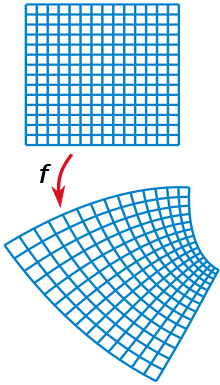Holomorphic function
![]()
This article describes holomorphy as a property of functions. For another meaning, see Holomorphy of a group.
Holomorphy (from Gr. ὅλος holos, "whole" and μορφή morphe, "form") is a property of certain complex-valued functions treated in function theory (a branch of mathematics). A function 


Even though the definition is analogous to real differentiability, it turns out in function theory that holomorphy is a very strong property. Namely, it produces a variety of phenomena that have no counterpart in the real. For example, every holomorphic function is arbitrarily often (continuously) differentiable and can be locally developed into a power series at any point.
Definitions
Let 



exists. It is then called 
The function 








Notes
Relationship between complex and real differentiability








where 
is. Now we see that the function is complex differentiable in 





has.
Cauchy-Riemann differential equations
→ Main article: Cauchy-Riemann partial differential equations
If we now decompose a function 


Consequently, the function 

are fulfilled.
Search within the encyclopedia







